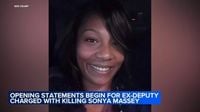The quiet city of Peoria, Illinois, has found itself thrust into the national spotlight as the murder trial of former Sangamon County sheriff’s deputy Sean Grayson unfolds, more than a year after the fatal shooting of Sonya Massey—a 36-year-old Black mother of two—inside her own home. The case, which began its trial phase on October 22, 2025, has become a focal point in the ongoing debate over law enforcement’s use of force, especially in encounters with Black Americans inside their residences.
The events that led to Massey’s death began on July 6, 2024, when she called 911 to report a suspected prowler at her Springfield, Illinois home. According to ABC News and the Associated Press, Massey, who struggled with mental health challenges, was seeking help, not confrontation. Deputies Sean Grayson and Dawson Farley responded, finding no evidence of an intruder. What happened next, captured on body camera footage and now central to the trial, has left a community grieving and a state grappling with questions of justice and police accountability.
The prosecution, led by Sangamon County State’s Attorney John Milhiser, argues that Grayson’s actions were not justified. In his opening statement, Milhiser told jurors, “Make no mistake, we are here in this courthouse today because of the actions of Sean Grayson. On July 6, 2024, in her kitchen, without lawful justification, he shot and killed [Sonya Massey]. That’s why we are here.” He emphasized that the body camera footage would show Massey posed no threat, highlighting Grayson’s disregard for police training and principles. “He did not follow his training. He did not follow police principles,” Milhiser said, according to AP.
The defense, represented by attorney Daniel Fultz, paints a very different picture. Fultz urged jurors not to rush to judgment, insisting that Grayson feared for his life. “Ms. Massey made the decision to lift the pot of boiling water above her head to attempt to throw that at Dept. Grayson. It was at that moment and only at that moment that Dept. Grayson discharged his weapon,” Fultz said. He argued that what happened to Massey was a tragedy but “it was not a crime.”
The heart of the case lies in the body camera footage, which jurors watched in court. The video, as described by WLS and ABC News, shows the deputies knocking on Massey’s door. Massey answers, visibly anxious, and pleads, “Please don’t hurt me.” Grayson responds, “I don’t want to hurt you; you called us.” Inside, Grayson notices a pot of boiling water on the stove and tells Massey, “We don’t need a fire while we’re in here.” The encounter, initially calm, escalates as Massey pours some water into the sink and says, “I rebuke you in the name of Jesus.” Grayson, apparently interpreting this as a threat, draws his weapon and, after a brief commotion, fires three shots—one striking Massey fatally below the eye.
The footage, played in court, prompted emotional reactions. Jurors recoiled, Massey’s mother left the courtroom in tears, and the weight of the tragedy hung heavy. Deputy Dawson Farley, Grayson’s partner that night, took the stand for the prosecution and delivered testimony that cut to the core of the case. “She never did anything that made me think she was a threat,” Farley said, adding that it was Grayson’s actions that heightened his own sense of danger. Farley explained that he wanted to “do right” by Massey by testifying, underscoring the gravity with which he viewed the events of that night.
Farley’s testimony was not without complexity. Under cross-examination, he acknowledged that his initial report, filed days after the shooting, cited fear of the hot water and stated Massey held the pot chest high. However, Farley later sought to amend his statement, clarifying it was Grayson’s reaction—not Massey’s actions—that rattled him, and that Massey was holding an oven mitt, not the pot, at chest height. The evolving narrative highlighted the confusion and split-second judgments that can dominate such encounters, but also the importance of clarity and accountability in police reports.
Illinois State Police conducted a review of the shooting and concluded that Grayson’s use of deadly force was unjustified. The fallout was swift: Grayson was fired from the Sangamon County Sheriff’s Office in July 2024 after he was indicted. Further scrutiny of Grayson’s background revealed a troubling pattern—he had held six different law enforcement jobs over four years and had two DUIs before becoming an officer, according to WLS. These revelations fueled public outrage and led Governor JB Pritzker to sign a law mandating stricter hiring practices and greater transparency for law enforcement agencies across Illinois.
The trial itself, moved from Springfield to Peoria due to intense media attention, features a jury of 12, with three alternates, and is expected to last two weeks. Witnesses for both the prosecution and defense include experts in police training, use of force, and body camera analysis. The case has sparked national conversations about law enforcement’s treatment of Black Americans, particularly in situations where mental health struggles intersect with policing.
The defense continues to assert that Grayson acted in self-defense, believing Massey intended to throw boiling water at him. After the shooting, Grayson discouraged his partner from retrieving a medical kit, reportedly saying, “No, headshot, dude. She’s done. You can go get it, but that’s a headshot,” as shown in body camera footage. This chilling exchange, along with Grayson’s own field report—“While on scene, I was in fear Dep. (redacted) and I were going to receive great bodily harm or death. Due to being in fear of our safety and life, I fired my duty weapon”—has further fueled the debate over whether his actions were reasonable or reckless.
For Massey’s family, the pain remains raw. Her mother, Donna Massey, has spoken publicly about the ongoing grief and the hope that the trial will bring accountability. Civil rights attorney Ben Crump, representing the family, called the shooting an “unnecessary, excessive use of force, completely unnecessary, certainly not justified.” The autopsy confirmed Massey died from a gunshot wound to the head.
If convicted, Grayson faces up to 45 years in prison. The outcome of this trial is being watched closely—not just in Illinois, but across the country—as a test of how the justice system responds when law enforcement’s use of deadly force is called into question, especially in the sanctity of a person’s own home. As testimony continues, the community waits for answers, and perhaps, a measure of justice.


